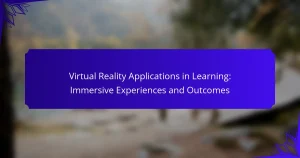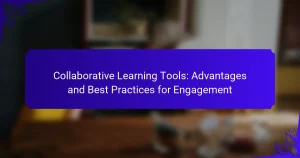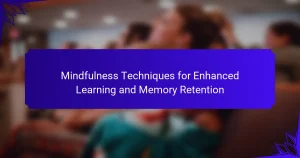Gamification in modern education significantly enhances student engagement and motivation. It transforms traditional learning into interactive experiences, improving information retention and fostering collaboration. Key implementation strategies include integrating game mechanics into lesson plans and utilizing digital tools for personalized learning. Challenges such as resource limitations and resistance to change must also be addressed for effective gamification.
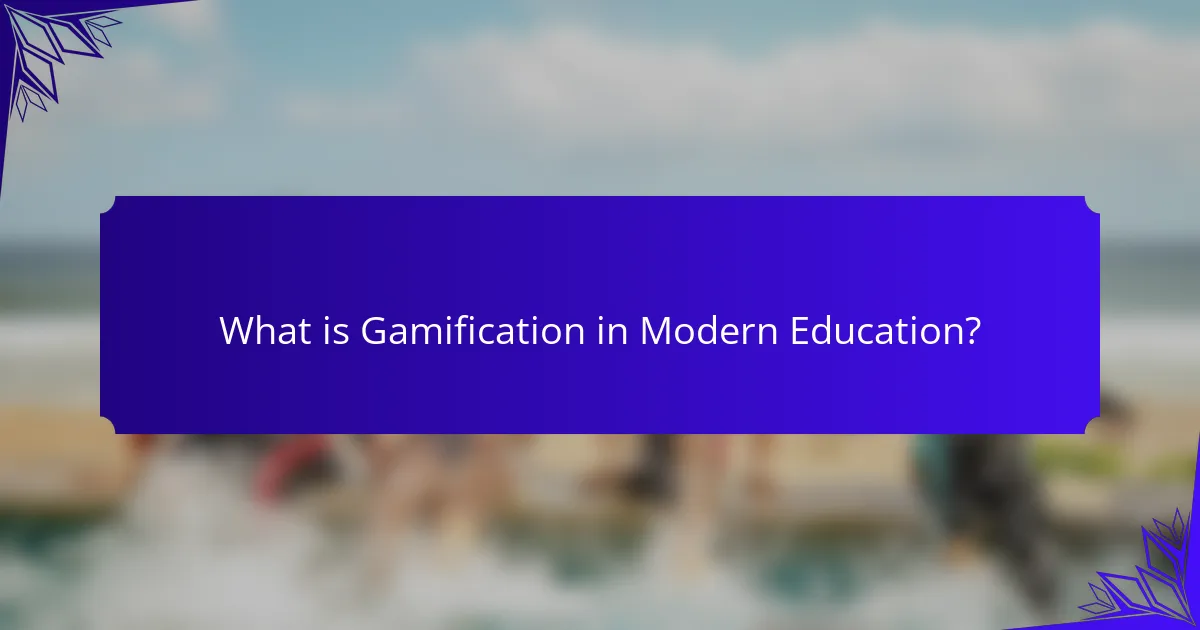
What is Gamification in Modern Education?
Gamification in modern education enhances engagement and motivation through game-like elements. It incorporates rewards, challenges, and competition to foster a dynamic learning environment. Key benefits include improved retention of information, increased participation, and the promotion of critical thinking skills. Implementation strategies involve integrating game mechanics into lesson plans, using digital tools, and providing feedback that encourages progress.
How does gamification enhance student engagement?
Gamification enhances student engagement by incorporating game-like elements into learning environments. This approach increases motivation, fosters competition, and encourages collaboration among students.
Game mechanics, such as points, badges, and leaderboards, create a sense of achievement. As a result, students are more likely to participate actively in their education. Studies indicate that gamified learning can improve retention rates by up to 75%.
Moreover, gamification allows for personalized learning experiences, catering to individual student needs and preferences. This adaptability can lead to higher satisfaction and engagement levels.
In implementing gamification, educators should focus on clear objectives, meaningful rewards, and relevant challenges to maximize its effectiveness.
What are the key components of gamification?
Gamification includes key components like game mechanics, motivation, feedback systems, and social interaction. These elements enhance engagement and learning outcomes in educational settings. Game mechanics involve points, badges, and leaderboards that foster competition. Motivation is driven by intrinsic and extrinsic factors, encouraging participation. Feedback systems provide real-time responses, aiding skill development. Social interaction promotes collaboration and community building among learners.
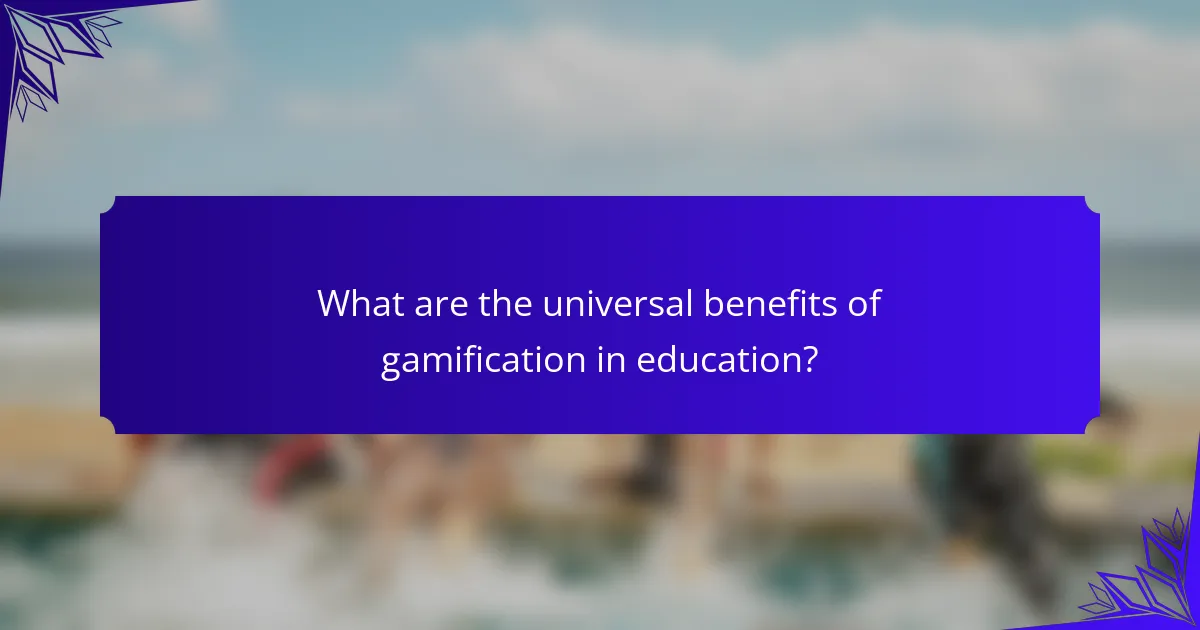
What are the universal benefits of gamification in education?
Gamification in education enhances engagement, motivation, and learning outcomes. It transforms traditional learning methods into interactive experiences, fostering a deeper connection with the material.
One significant benefit is increased student engagement. Gamified elements, such as rewards and challenges, create a stimulating environment that encourages participation. Research shows that 70% of students feel more motivated when learning through gamification.
Another advantage is improved retention of information. Interactive activities help students remember concepts better than passive learning methods. A study found that gamified learning can increase information retention rates by up to 30%.
Additionally, gamification promotes collaboration among students. Team-based challenges encourage communication and teamwork, essential skills for future workplaces.
Lastly, it allows for personalized learning experiences. Educators can tailor gamified activities to meet individual student needs, enhancing the overall educational experience.
How does it improve learning outcomes?
Gamification enhances learning outcomes by increasing engagement and motivation among students. It incorporates game elements, such as rewards and challenges, fostering a more interactive learning environment. As a result, students exhibit improved retention of information and higher academic performance. Research indicates that gamified learning experiences can lead to a 30% increase in student performance metrics. This unique approach encourages collaboration and problem-solving skills, essential for real-world applications.
What role does motivation play in gamified learning?
Motivation is crucial in gamified learning as it enhances engagement and drives participation. When learners are motivated, they are more likely to persist through challenges and achieve learning goals. Gamification leverages elements like rewards, competition, and achievement badges to stimulate intrinsic and extrinsic motivation. As a result, students experience improved retention and satisfaction. This unique approach transforms traditional education, making learning more interactive and enjoyable.
How does gamification foster collaboration among students?
Gamification fosters collaboration among students by creating engaging environments that encourage teamwork. It promotes shared goals and mutual support, enhancing communication skills. Game mechanics, such as rewards and challenges, motivate students to work together to achieve objectives. Collaborative tasks within gamified systems lead to improved peer interactions and a sense of community. As a result, students develop essential social skills while learning effectively.
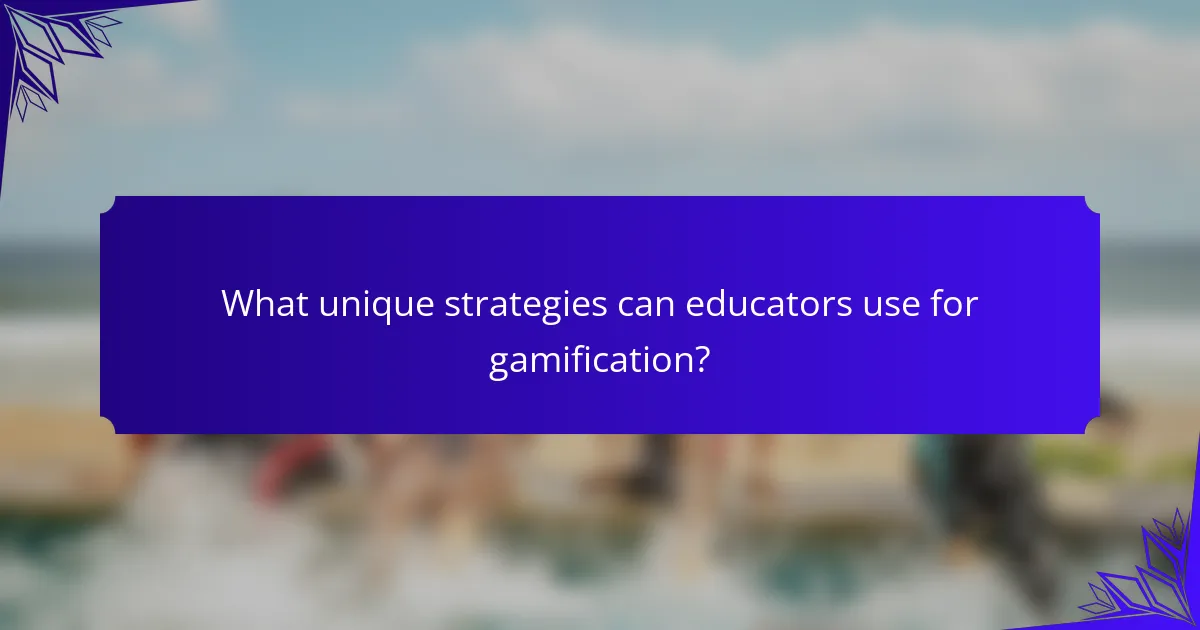
What unique strategies can educators use for gamification?
Educators can enhance gamification by incorporating unique strategies like personalized learning paths, real-time feedback mechanisms, and collaborative challenges. These approaches foster engagement and motivate students. Personalized learning paths adapt to individual student needs, while real-time feedback provides immediate insights into progress. Collaborative challenges encourage teamwork and problem-solving, enhancing social interaction.
What are the best gamification tools available for educators?
Gamification tools enhance engagement and learning in education. Popular tools include Kahoot!, Quizizz, Classcraft, and Edmodo, which offer interactive and competitive elements for students. These platforms support various learning styles and foster collaboration, making education more enjoyable and effective.
How can storytelling be integrated into gamified lessons?
Storytelling can enhance gamified lessons by creating immersive experiences that engage students. Integrating narratives fosters emotional connections, making learning memorable. For instance, educators can craft story arcs that align with lesson objectives, helping students relate to content through characters and challenges. This approach not only boosts motivation but also improves retention of knowledge.
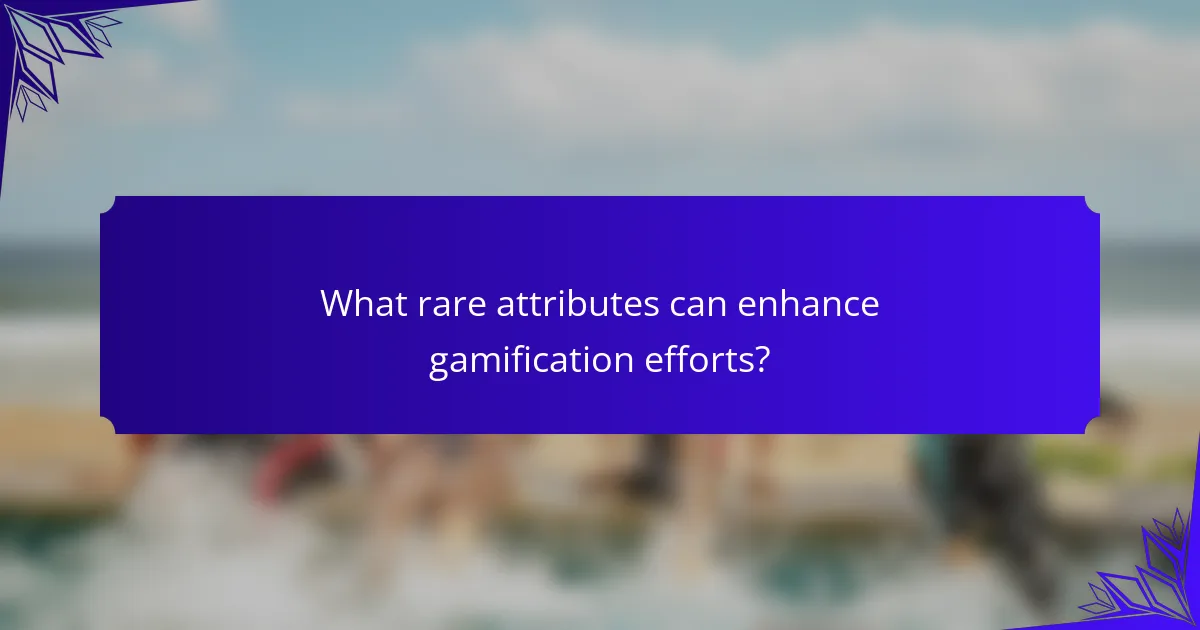
What rare attributes can enhance gamification efforts?
Rare attributes that can enhance gamification efforts include personalized feedback mechanisms, adaptive difficulty levels, and social collaboration features. Personalized feedback provides tailored insights, improving engagement. Adaptive difficulty adjusts challenges based on user performance, maintaining motivation. Social collaboration fosters teamwork and community, enriching the learning experience. These attributes create a more dynamic and effective gamified environment.
How can personalized feedback be implemented effectively?
Personalized feedback can be effectively implemented through targeted strategies that enhance student engagement. First, utilize data analytics to assess individual learning patterns. Second, integrate real-time feedback mechanisms within gamified learning platforms. Third, encourage peer feedback through collaborative activities. Finally, tailor feedback to align with specific learning goals, fostering a sense of achievement and motivation. These strategies leverage gamification to create a more personalized educational experience.
What are the impacts of cultural context on gamification strategies?
Cultural context significantly influences gamification strategies in education by shaping engagement and motivation. Understanding local values, norms, and learning styles enhances the effectiveness of gamified elements. For instance, collectivist cultures may respond better to team-based challenges, while individualistic cultures might prefer personal achievements. Adapting content to reflect cultural nuances leads to improved learner outcomes and satisfaction.
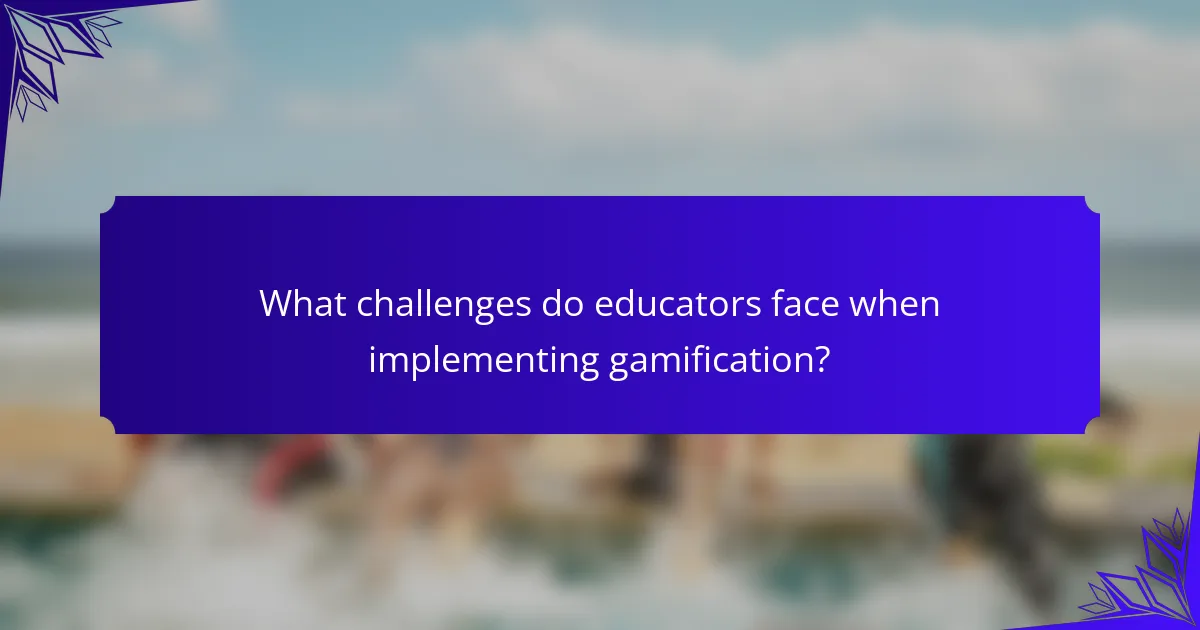
What challenges do educators face when implementing gamification?
Educators face several challenges when implementing gamification in modern education. Key issues include a lack of resources, insufficient training, and resistance to change among staff.
Limited budgets can restrict access to technology and tools necessary for effective gamification. Additionally, many educators may not receive adequate training on how to integrate gamification strategies into their teaching practices, leading to ineffective implementation.
Resistance to change can stem from traditional educational mindsets, making it difficult for some educators to embrace new methodologies. Furthermore, evaluating the effectiveness of gamification can be challenging, as it requires measurable outcomes that may not be immediately apparent.
Lastly, maintaining student engagement over time can be difficult, as novelty may wear off, necessitating continuous innovation in gamified approaches.
How can teachers overcome resistance to gamification?
Teachers can overcome resistance to gamification by demonstrating its effectiveness and aligning it with educational goals. Engaging stakeholders through workshops can build understanding and acceptance. Providing training ensures teachers feel confident in using gamification tools. Collecting and sharing success stories from peers can inspire others to adopt these strategies. Encouraging gradual implementation allows for adjustment and refinement, reducing apprehension.
What are common pitfalls in gamifying education?
Common pitfalls in gamifying education include overemphasis on rewards, lack of clear objectives, and ignoring diverse learner needs. Over-reliance on extrinsic motivation can diminish intrinsic interest in learning. Without clear goals, students may feel lost, leading to disengagement. Additionally, failing to accommodate different learning styles can alienate some students, reducing overall effectiveness.
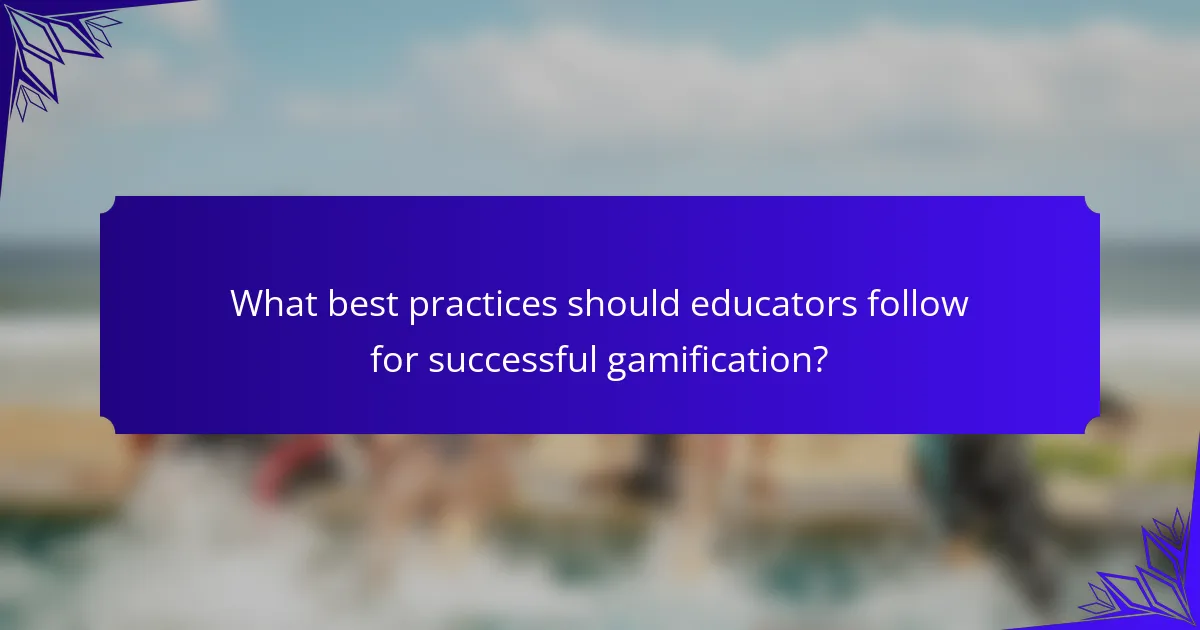
What best practices should educators follow for successful gamification?
Educators should focus on clear objectives, engaging content, and feedback mechanisms for successful gamification. Establishing specific learning goals enhances motivation and direction. Incorporating interactive elements, such as challenges and rewards, fosters engagement. Regular feedback helps students track progress and adjust strategies, promoting a growth mindset. Utilizing technology tools can streamline the implementation process, making it easier to integrate gamification into the curriculum.
How can assessment methods be adapted for gamified environments?
Assessment methods can be adapted for gamified environments by integrating interactive elements that enhance engagement. Incorporating real-time feedback, using game mechanics like points and badges, and allowing collaborative tasks can motivate learners. These adaptations encourage active participation and improve knowledge retention. Additionally, assessments can be designed to simulate real-world challenges, making learning relevant and immersive. By aligning assessment strategies with gamification principles, educators can create a dynamic learning experience that supports diverse learning styles and promotes critical thinking.
What tips can enhance the effectiveness of gamified learning experiences?
Engaging learners through gamified experiences enhances motivation and retention. Incorporate clear objectives to guide learners, fostering a sense of purpose. Use immediate feedback mechanisms to reinforce learning and encourage progression. Design challenges that match skill levels, promoting a balance between difficulty and achievement. Integrate social elements, allowing collaboration and competition to boost engagement. Lastly, ensure the learning environment is visually appealing and interactive, enhancing the overall experience.
